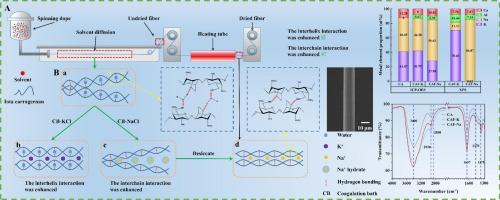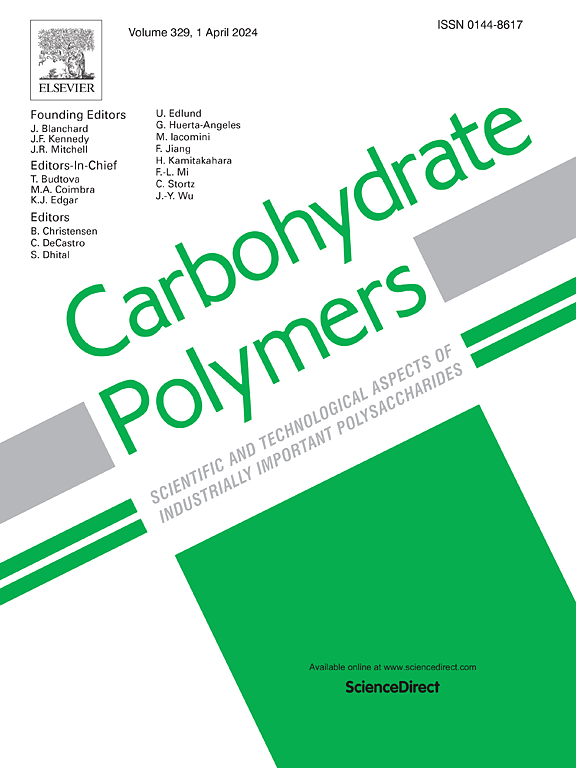Preparation of carrageenan fibers promoted by hydrogen bonding in a NaCl coagulation bath
IF 10.7
1区 化学
Q1 CHEMISTRY, APPLIED
引用次数: 0
Abstract
Carrageenan fibers developed by wet spinning have been extensively studied due to their remarkable flame-retardant characteristics. However, its mechanical properties have not been significantly improved, which limits the further development of carrageenan fibers. Traditionally, the first coagulation bath has been selected as a KCl solution, which can promote the formation of gels from carrageenan without reacting with NaOH to produce precipitates. In this study, a new type of carrageenan fiber was prepared for the first time employing an underappreciated NaCl solution as the first coagulation bath in combination with an AlCl3 coagulation bath. A comparison was made using fibers produced with KCl as the first coagulation bath under the same conditions. The potential mechanism of wet forming of carrageenan fibers was revealed using performance testing, compositional analysis, and structural characterization, which systematically investigated the differences between the two fibers. In contrast to prior studies, the NaCl coagulation bath primarily promoted hydrogen bonding between carrageenan molecular chains, and the produced fibers outperformed the KCl coagulation bath.

在氯化钠凝固浴中通过氢键促进卡拉胶纤维的制备
通过湿法纺丝开发的卡拉胶纤维因其显著的阻燃特性而被广泛研究。然而,其机械性能并未得到显著改善,这限制了卡拉胶纤维的进一步发展。传统上,第一凝固浴选择的是 KCl 溶液,它能促进卡拉胶形成凝胶,而不会与 NaOH 反应产生沉淀物。在本研究中,首次使用了未被充分重视的 NaCl 溶液作为第一凝固浴,并结合 AlCl3 凝固浴制备了一种新型卡拉胶纤维。在相同条件下,使用 KCl 作为第一凝固浴制备的纤维进行了比较。通过性能测试、成分分析和结构表征,系统地研究了两种纤维之间的差异,揭示了卡拉胶纤维湿法成型的潜在机理。与之前的研究不同,NaCl 混凝浴主要促进了卡拉胶分子链之间的氢键结合,生产出的纤维性能优于 KCl 混凝浴。
本文章由计算机程序翻译,如有差异,请以英文原文为准。
求助全文
约1分钟内获得全文
求助全文
来源期刊

Carbohydrate Polymers
化学-高分子科学
CiteScore
22.40
自引率
8.00%
发文量
1286
审稿时长
47 days
期刊介绍:
Carbohydrate Polymers stands as a prominent journal in the glycoscience field, dedicated to exploring and harnessing the potential of polysaccharides with applications spanning bioenergy, bioplastics, biomaterials, biorefining, chemistry, drug delivery, food, health, nanotechnology, packaging, paper, pharmaceuticals, medicine, oil recovery, textiles, tissue engineering, wood, and various aspects of glycoscience.
The journal emphasizes the central role of well-characterized carbohydrate polymers, highlighting their significance as the primary focus rather than a peripheral topic. Each paper must prominently feature at least one named carbohydrate polymer, evident in both citation and title, with a commitment to innovative research that advances scientific knowledge.
 求助内容:
求助内容: 应助结果提醒方式:
应助结果提醒方式:


